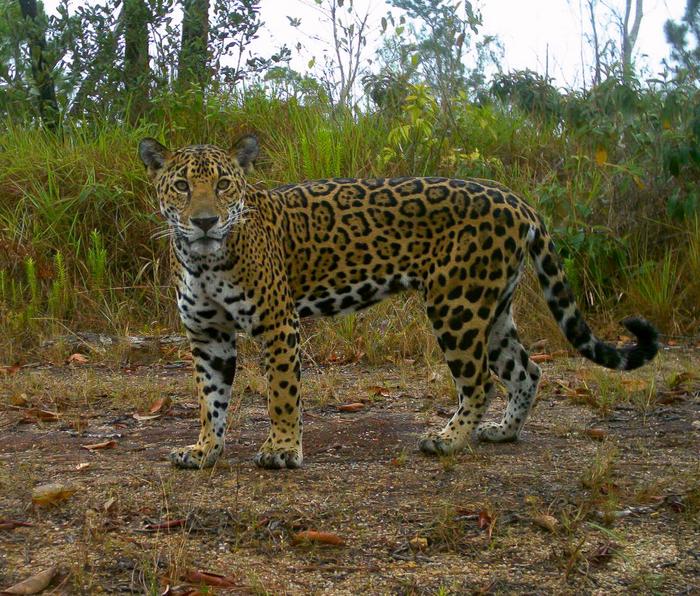How do you study a predator with both camouflage and stealth that make it virtually invisible in the forest?

Credit: Belize Jaguar Team/Virginia Tech
How do you study a predator with both camouflage and stealth that make it virtually invisible in the forest?
Even jaguars poop.
A team of researchers led by the University of Cincinnati applied genetic and isotopic analyses to jaguar scat to investigate the habitat needs of the big cats in the Mountain Pine Ridge Forest Preserve of Belize in Central America. The study demonstrates a novel and noninvasive technique for identifying the landscape use and conservation needs of elusive wildlife.
Researchers used scat-detecting dogs named Billy and Bruiser to find telltale evidence left behind by jaguars in the reserve, which is also home to pumas, margays, ocelots and jaguarundis. They subjected the scat to genetic analysis, known as molecular scatology, to identify not just species but also the individual cats that produced each sample. Researchers then subjected the scat to isotopic analysis, which offers clues about where the animal hunted based on the geology and vegetation of the area.
Published in the European Journal of Wildlife Research, the study concluded that the combination of genetic and isotopic analysis provides a powerful, noninvasive approach to surveying wildlife for conservation.
“We’re not interacting with the animal directly,” said Brooke Crowley, lead author and a professor of geosciences and anthropology at the University of Cincinnati. “There’s no trapping or darting. You might never see the animal, but can determine what it ate and where it ate it.”
The Mountain Pine Ridge Forest Reserve covers about 267 square miles of forest, savanna, rocky mountains, caverns and streams in central Belize. The reserve is logged on a rotating basis. The roads are largely unpaved and many are overgrown.
Tracking animals here is extremely difficult, said Claudia Wultsch, a study co-author and research fellow at the City University of New York.
“Jaguars tend to stay away from people and are typically found at more remote sites. You have to be extremely lucky to see one in the wild,” Wultsch said.
Isotopic analysis is a good alternative to study an animal that is solitary, wide-ranging, nocturnal, wary of people and dangerous to capture. And it complements other wildlife surveillance methods such as camera trapping, acoustic monitoring and environmental DNA analysis.
Bigger than leopards, jaguars are the world’s third-largest cat and the biggest found in the Western Hemisphere. They are powerful apex predators that were revered by pre-Columbian societies. Opportunistic hunters, jaguars consume a wide variety of prey, including small mammals, birds, fish and reptiles. In Belize, they often eat armadillos, coatis and deer.
“Belize is an important stronghold for jaguars,” co-author Wultsch said. She is studying the big cats with study co-author Marcella Kelly, a professor at Virginia Tech.
In Belize, jaguars are protected and live in a network of dedicated reserves. Wultsch and Kelly in 2000 found that jaguars had a large enough population to maintain genetic diversity in Belize but did see some habitat loss and fragmentation in parts of their historic range.
In the latest project, the jaguars the researchers studied hunted prey in the reserve’s pine forest savanna rather than in denser forest or nearby agricultural areas. Male jaguars had territory covering some 60 square miles. As in other areas where jaguars have been studied, researchers found that some of the male jaguars had partially overlapping territories.
They also found some evidence that the jaguars were avoiding areas where prey was scarce from recent wildfires. This corroborates a camera trapping study that had fewer sightings of both jaguars and their prey in these areas as well.
“Some forested areas in Belize have become more fragmented and isolated over the last 50 years, so one of the objectives of our research is to assess how jaguars are doing at several protected areas across Belize,” Wultsch said.
The study was supported by grants from the Virginia Tech Department of Fish and Wildlife Conservation, the Explorers Club, the nonprofit group Panthera, the National Geographic Society, the Oregon Zoo, the Woodland Park Zoo, the Roger Williams Park Zoo and the Wildlife Conservation Society.
Journal
European Journal of Wildlife Research
DOI
10.1007/s10344-023-01701-2
Method of Research
Observational study
Subject of Research
Animals
Article Title
Integrating fecal isotopes and molecular scatology to non-invasively study the spatial ecology of elusive carnivorans: a case study with wild jaguars (Panthera onca)
Article Publication Date
17-Jul-2023
COI Statement
None to report.




